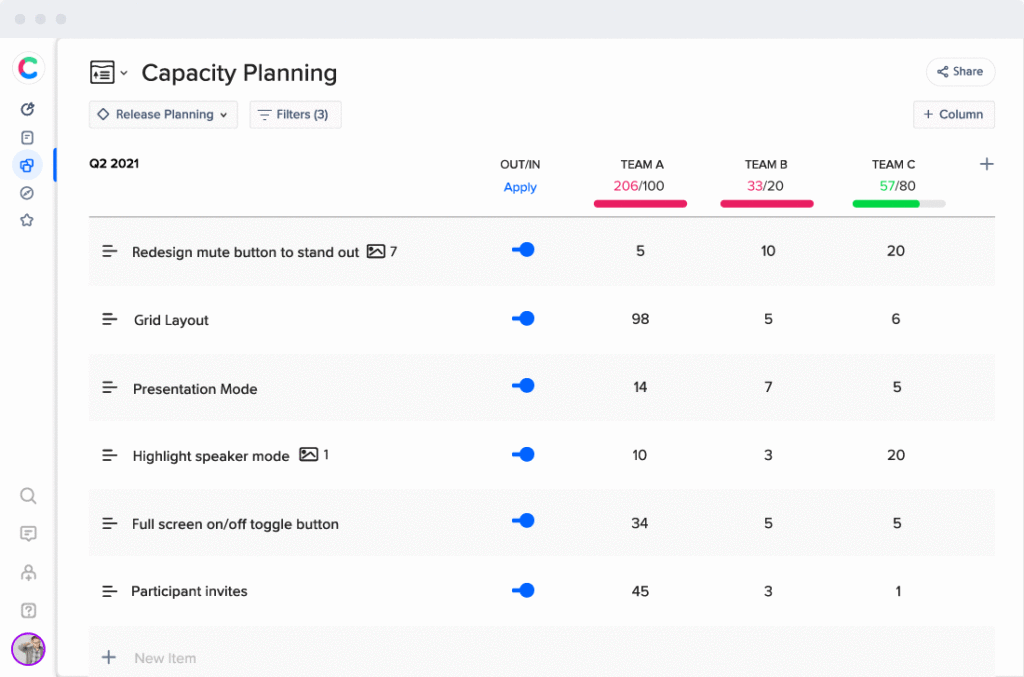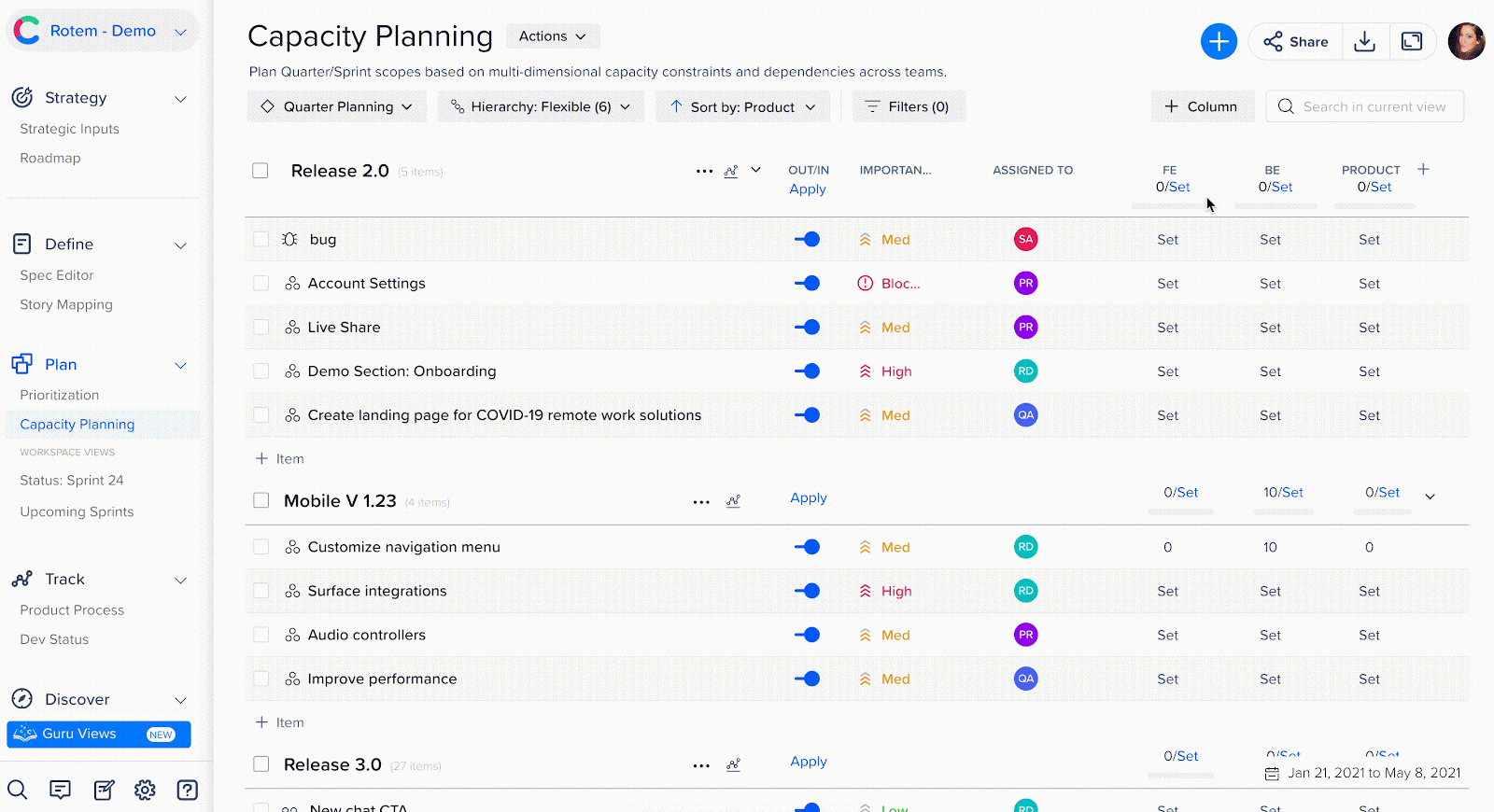Home > Blog > Capacity Planning: Tactics, Benefits, and Tools
Capacity Planning: Tactics, Benefits, and Tools

What Is Capacity Planning?
In product management, capacity planning involves coordinating and deploying your available resources according to the priorities of your product team and customers. Put more simply: Capacity planning is a process to help your company get the most value from its resources.
In practice, this means reviewing your company’s priorities and plans for your products over time, and then figuring out how best to allocate your development team’s time to achieve as many of your objectives as possible.
What capacity planning looks like in an agile environment.
Let’s say you’re a Product Manager with a SaaS company and your team wants to build and release a new Minimum Viable Product (MVP) in the next nine months. Let’s also assume you’ve already done the early work of defining your user persona, talking with many people in that role about their challenges and goals, and using their feedback to determine the most valuable functionality to include in your MVP.
Before your developers can begin work, you need to coordinate with the development team and answer some important strategic questions. For example:
- How much effort (measured in story points, for example) will building this new MVP require?
- To what degree are the development teams you’ll need for this MVP already committed to other work during the same timeframe?
- Can you make the case that your MVP should take precedence over some of the teams’ existing tasks?
- Do the development teams with time available to help you with this MVP also have the necessary skill sets?

If the product and development teams in this hypothetical scenario work together to think through these answers, they will be in a much better position to ensure they can build and launch the MVP successfully according to their plan.
What Are the Benefits of Capacity Planning?
As a Product Manager, you’ll always have more items on your wish-list than your company has the time, budget, and resources to complete in the timeframe you’d like.
To give your products the best chance of market success, you’ll need to prioritize your roadmap with the most strategically advantageous items to work on next. As we point out in our online guide to capacity planning, prioritization is step 1. Step 2 is to assess your capacity to complete the items you’ve just prioritized.
In fact, combining your product prioritization and capacity planning into a single process can save your product and development teams even more time and frustration. And that’s just one example of the value of capacity planning. Here are some of the most important reasons to build it into your team’s process.
You’ll complete more of your valuable work on time.
The farther into a project you are when your team realizes it doesn’t have the resources or skills to complete the work, the longer that project is going to be delayed, as the team regroups to figure out how to proceed.
When you conduct effective capacity planning before the team begins its work, you’ll have a much more accurate sense of how to allocate resources and time, and at what intervals to expect the team to achieve specific milestones along the way.
You’ll make your customers happier.
When a product team signals that customers can expect upgrades or new functionality within a given timeframe — and then fails to deliver within that timeframe — customers (and any prospective customers paying attention) can become frustrated or less trustful of that company.
Intelligent capacity planning helps your team avoid the pitfall of missed release timeframes. It can also help you push out features (and entirely new products) more often, which will also delight your customer base even if they’re not expecting them by a certain date.
You’ll align your output to your objectives.
Every team can be kept busy — but busy doesn’t necessarily equate to producing the most valuable features and products.
Effective capacity planning gives your team another useful metric for weighing which items to work on next: whether you’ll have the resources to get that work done. This can help your team align your output to your priorities and business objectives.
Types of Capacity Planning
Up to this point, we’ve been discussing capacity planning broadly, as if it was a single process. But there are several types of capacity planning, and it’s important to understand the differences among them. You’ll want to choose the approach that most closely matches your company’s circumstances and corporate culture.
As you plan your resource levels, you have essentially three options: you can staff only enough to meet current needs, over-staff in anticipation of a future need, or try to match your staffing needs along the way and make minor adjustments as the need arises.
Let’s review these three approaches now.
1. Lag strategy
The most conservative framework is lag-based capacity planning. Under this framework, you’ll hire only enough resources to take on the work you’ve already planned. Only if you begin experiencing an increased demand for resources will you bring on more people.
This approach makes sense for startups or smaller companies with lower current capacity requirements. However, if you don’t foresee the need for a significant increase in resources, you might not want to over-staff ahead of time and leave a lot of people idle.
2. Lead strategy
The lead capacity planning approach is more proactive and aggressive than the lag strategy. With lead planning, you’d hire more resources than you need now in anticipation of an increase in demand.
This approach makes sense for larger companies and businesses entering a growth phase. These organizations are likely to have a growing need for developers, UX designers, and other employees as they add more initiatives to their roadmaps.
3. Match strategy
The match approach to capacity planning represents a middle ground between the lead and lag strategies. With this framework, you’d be closely monitoring your company’s ongoing need for resources and making small adjustments along the way based on both current needs and anticipated needs according to your near-term forecasting.
Match-based capacity planning makes sense for businesses with shorter development cycles and do not regularly commit to longer-term plans.
Make Capacity Planning a Product Management-Development Partnership
As you’re building a capacity planning framework for your organization, it’s important to keep in mind that Product Managers cannot conduct these exercises in a vacuum. For at least two important reasons, you should treat capacity planning as an equal partnership between the product and development teams.
1. Your estimates will be more accurate.
A necessary step in capacity planning is assessing how much effort each of the proposed work items will require. You can measure effort in terms of person-hours, story points, or some other metric — but the point is to score that metric as accurately as possible. If you assume your developers can complete a user story in three days — but they later tell you it will take a full week — your plans and assumptions will be inaccurate.
This is one reason you’ll want to work closely with your developers from the beginning, to ensure your capacity planning exercise leads to accurate estimates.
2. It’ll improve the all-important relationship between product and dev.
According to a study in ScienceDirect, capacity planning is a dynamic process in the sense that if a business overly stresses its resources, those resources will reset to a lower level of exertion to protect themselves against future harm.
If Product Managers regularly underestimate the effort needed to complete specific tasks, the development team will likely become frustrated and exhausted and build in buffer time to protect against being overworked in the future.
By contrast, when the product team treats the development team as partners and equals — and shows trust in their expertise — this all-important relationship becomes stronger. In fact, developers in those circumstances will want to deliver their best work to their product management partners.
What Are the Best Capacity Planning Tools?
According to the craft.io 2023 State of Product Management Report, the number one challenge facing Product Managers today is capacity planning.
We believe much of the challenge comes down to the fact that product professionals simply don’t have an effective capacity planning tool. So, what would such a tool include? Here are a couple of must-haves:
1. A central location for all product content, company wide.
If you’re using spreadsheets to maintain your backlog, pouring that content into a separate tool (like presentation software) to build and update your roadmaps, and monitoring your developers’ tasks in a workflow app like Jira, it’s highly unlikely you’ll have the full picture of your company’s available resources and current commitments.
The right capacity planning tool will make it easy for you to bring all this information together in one location — so you can see exactly what your development teams are up to, across the company, and begin measuring your available resources against your planned work.

2. The ability to quickly assess how planning changes affect capacity.
Another important capability for capacity planning — which very few tools offer — is the ability to test in real-time how adjusting teams’ plans or workloads might affect the overall plans.
It’s also important that the product and dev teams can conduct these exercises without affecting the live roadmap, something else you won’t find with most product management tools (but you will with craft.io).



